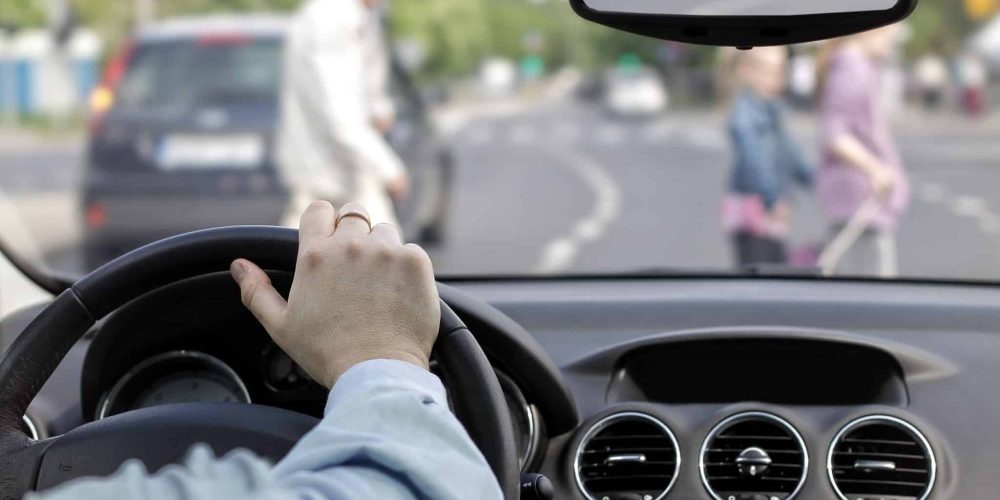More than 7,600 pedestrians died in motor vehicle accidents in 2019. Pedestrian and bicyclist motor vehicle deaths have been on the rise in the last ten years. In fact, over the course of ten years, bicyclist deaths have increased by 38% and pedestrian deaths by 40%. 2019 saw the most pedestrian fatalities in 30 years. Pedestrian Detection is one vehicle safety technology that can make a difference, reducing pedestrian accidents, saving lives, and avoiding injuries. Pedestrian Detection has become increasingly available on new cars in the United States. In this article, we will define Pedestrian Detection systems, explain how they work, explore their limitations, and discuss the state of the industry today — all to get you up-to-date on the subject.
What is Pedestrian Detection in Cars?
Pedestrian Detection (PD) is an advanced driver assistance system (ADAS) that detects pedestrians (and sometimes bicyclists and pets) in a vehicle’s path. Once a risk is detected, Pedestrian Detection provides an audible, visual, or haptic warning to drivers.
Some Pedestrian Detection systems just provide a warning. Others add automatic emergency braking (AEB) capabilities into the mix. So, in vehicles equipped with pedestrian automatic emergency braking, if the driver doesn’t brake following a pedestrian warning, the AEB is initiated to apply the brakes. Not all vehicles with PD have AEB, and vice versa.
Above all, Pedestrian Detection has the potential to save lives — up to 810 lives would be saved annually if all U.S. cars had Pedestrian Detection.
How does Pedestrian Detection technology work?
Accurately detecting pedestrians isn’t simple. It’s a fundamental problem when it comes to computer vision and object detection in vehicle sensing technology. As an ADAS, Pedestrian Detection uses data from advanced vehicle sensors for information about the vehicle’s surroundings. Most commonly, PD uses forward radar and/or camera imaging sensors, but some use LiDAR as well.
Depending on which ADAS sensors your vehicle utilizes for PD, your system will have different strengths and weaknesses. Here’s a chart showing each sensor’s strengths and weaknesses, with respect to Pedestrian Detection.
| Strengths | Weaknesses | |
|---|---|---|
| Radar Sensor | Not affected by weather conditions, lighting conditions, and dirt | Worst at Pedestrian Detection |
| Camera Sensor | Best at Pedestrian Detection | May not work under some weather conditions, lighting conditions, and even dirt |
| LiDAR Sensor | Less affected by weather, lighting, and dirt | Still somewhat sensitive to rain and fog, blinded by direct sunlight |
Sensor fusion, or the fusion of data from different sensors to model your vehicle’s surroundings, is extra important for this ADAS. Most commonly, data from camera and radar sensors are combined to form a more accurate model.
AEB and Pedestrian Detection
Pedestrian Detection is often shown as a feature of a vehicle’s forward crash prevention and mitigation system. These safety systems usually include detection of a forward crash risk, a collision warning, and automatic braking (AEB).
As of 2022, AEB is standard, but not all AEB systems are capable of stopping for pedestrians, cyclists, or pets. PD is such an important feature of AEB, that Consumer Reports no longer gives vehicles credit for city speed AEB unless PD is included. Additionally, the IIHS started testing pedestrian AEB in 2019.
Pedestrian Detection Today
Today, many new vehicles in the United States either have PD standard or as an optional feature. It doesn’t work every time, in every situation. Many PD systems as they are now, have trouble seeing pedestrians in low light. But, some brands are better than others. Meanwhile, PD technology trends are moving the field forward in LiDAR and thermal imaging.
While most existing systems use a camera, radar, or both for Pedestrian Detection, LiDAR for ADAS is emerging as an up-and-coming PD solution because of how vital it is for autonomous cars. LiDAR improves on camera, radar, and hybrid systems by performing well during the day and night. It also offers technological benefits, including real-time free space detection while tracking objects.
Thermal imaging aims to improve pedestrian safety systems’ performance in the dark and in low-light situations by using infrared heat sensors. Thermal Imaging Cameras may be available on new vehicles by 2025, according to Consumer Reports. Likely, these cameras won’t replace radar and camera sensors. Rather, it will become an additional sensor contributing data to more accurately model a vehicle’s surroundings.
When do PD sensors need calibration?
To benefit from your Pedestrian Detection system warnings and AEB, your sensors need to be clean and properly calibrated. ADAS calibration is called for after several common circumstances — collisions, fender benders, windshield replacement, and more.
Few auto shops offer in-house ADAS calibrations. At Car ADAS Solutions, we help shops overcome ADAS calibration obstacles. You can focus on your core business, while we launch this high ROI revenue stream. Our solutions help clients open and manage ADAS calibration centers. With our network of leading ADAS equipment partners, we provide a comprehensive slate of services — site certification, technician training, initial implementation, ongoing support, and even quality control for your ADAS calibration center.







